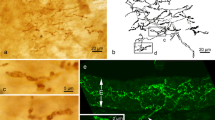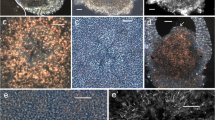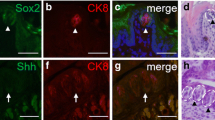Abstract
Morphological changes in developing human gustatory papillae during the 6th to the 23rd postovulatory week have been studied. The general innervation pattern of taste papillae and taste bud primordia was revealed immunohistochemically using antibodies against protein gene product 9.5 (PGP9.5), neurofilament H (NFH), neurofilament L (NFL), neurone-specific enolase (NSE), and tubulin. The autonomic and somatosensory nerve supply has been investigated using antibodies against substance P (SP), calcitonin gene-related peptide (CGRP), tyrosine hydroxylase (TH), neuropeptide Y (NPY), the neuronal form of nitric oxide synthase (n-NOS), and, enzyme histochemically, NADPH-diaphorase. Nerve fibers approach the basal membrane of the lingual epithelium around the 7th postovulatory week and invade the epithelium of papilla-like structures at the 8th week, but some also penetrate the basal membrane of the non-papillary epithelium. They are in close contact with slender epithelial cells that are considered to be the taste bud’s progenitor cells. Early human taste buds situated at the anterior part of the tongue do not necessarily require a dermal (later fungiform) papilla. The NADPH-diaphorase reaction revealed positive results in dermal nerve fibers, but the immunohistochemical reaction against n-NOS was negative. Immunohistochemical detection of neuropeptides and vasoactive substances rendered negative results for developmental stages of 7–18 postovulatory weeks. By the 18th week, only SP was detected in dermal papillae, but not in the vicinity of taste buds’ primordia. Thus, autonomic and somatosensory nerves seem not to play a key role in formation and maintenance of early human taste buds.
Similar content being viewed by others
Author information
Authors and Affiliations
Additional information
Accepted: 31 July 1997
Rights and permissions
About this article
Cite this article
Witt, M., Reutter, K. Innervation of developing human taste buds. An immunohistochemical study. Histochemistry 109, 281–291 (1998). https://doi.org/10.1007/s004180050228
Issue Date:
DOI: https://doi.org/10.1007/s004180050228




